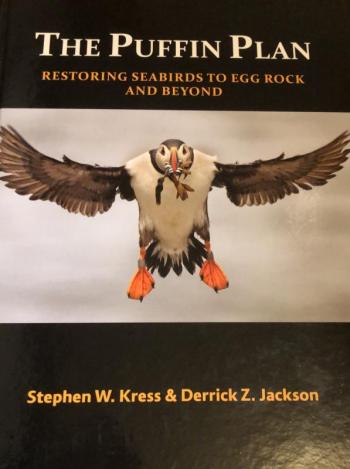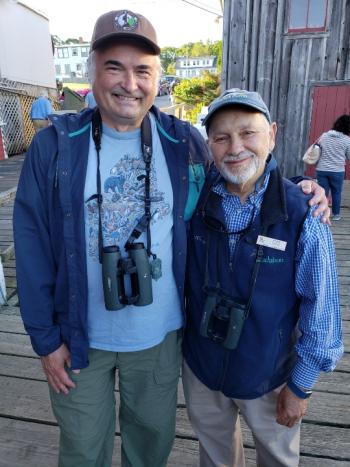The Puffin Plan
Steve Kress came to Maine to teach at the famous Hog Island Audubon Camp in Bremen in 1969, when we were just toddlers. He has been working to restore and manage seabird populations in the state ever since then—for more than 50 years. Ironically, we first met Steve, not here in Maine, but 500 miles away in land-locked Ithaca, New York, when we were students at Cornell University, which is located there.
Steve had been working in Maine for almost 30 years by then. We had, of course, heard of him as the famous “puffin man”—the person who had used new, innovative techniques and incredibly hard work to bring those dramatic, orange-billed seabirds back to an island where they had not been seen for a hundred years. We have been fortunate to be able to get to know Steve over the last 20-plus years and to even spend time in the field with him on and around Eastern Egg Rock, the island that Steve’s work repopulated with puffins and later, with terns as well.
And yet, despite having heard the story of Steve’s work many times before, we confess to being totally enamored with Steve’s latest new book, The Puffin Plan – Restoring Seabirds to Egg Rock and Beyond (Tumblehome Books, 2020). In the book, Steve (and co-author Derrick Jackson) tells the story of how he came to become interested in birds, the circuitous path that led him eventually to Audubon’s Hog Island Camp in Maine, and how some time spent reading Ralph Palmer’s book, Maine Birds, in the camp library changed his life forever. It was in that book that he read that puffins had nested on Eastern Egg Rock, about eight miles out to sea from Hog Island, until the 1870s. Could puffins ever nest there again, he thought, and what would it take to make it happen?
In a delightful, easy-to-read style that makes the reader feel as though they are having a conversation with Steve himself, the book recounts the intimate details of the incredible journey that eventually did make Eastern Egg Rock the site of the first successful seabird restoration project in the world. Along the way Steve and his team had many ups and downs and they pioneered new techniques that are now used all around the world to restore and manage seabird populations. We loved the tales of how the tools and techniques were used to bring back murres to a sea stack off the California coast, help endangered short-tailed albatrosses on a Japanese island, relocate Caspian terns to a safer island in the Pacific Northwest, and to manage African penguins in South Africa. A chapter on how climate change is impacting the Gulf of Maine—and the puffins—is engrossing as well as alarming, but Steve ends on a positive note explaining why he has hope for puffins and other seabirds as well as the health of the world. One of the last chapters in this memorable book is the one that gives tribute to the more than 700 interns that have worked with the Puffin Project over the last 50 years.
We heartily recommend this wonderful book for bird lovers, nature enthusiasts, and lovers of the Maine coast.
Jeffrey V. Wells, Ph.D., is a Fellow of the Cornell Lab of Ornithology and Vice President of Boreal Conservation for National Audubon. Dr. Wells is one of the nation's leading bird experts and conservation biologists and author of the “Birder’s Conservation Handbook.” His grandfather, the late John Chase, was a columnist for the Boothbay Register for many years. Allison Childs Wells, formerly of the Cornell Lab of Ornithology, is a senior director at the Natural Resources Council of Maine, a nonprofit membership organization working statewide to protect the nature of Maine. Both are widely published natural history writers and are the authors of the popular books, “Maine’s Favorite Birds” (Tilbury House) and “Birds of Aruba, Bonaire, and Curaçao: A Site and Field Guide,” (Cornell University Press).





























